Lending? NO PROBLEM!
U need just Chrome whit METAMASK and us!
Demonstration of the DAPP
In this section, we will demonstrate how ETHLend DAPP works from the user experience perspective. We will go step-by-step walk-through on how to request a loan and to fund a loan. You will need to have Google Chrome and the MetaMask plugin installed. MetaMask is Google Chrome plugin to allow decentralized application, such as, ETHLend, to be run in the browser without downloading the full Ethereum node.
To download Google Chrome, please visit:
To download MetaMask, please visit:
Click ‘GET CHROME PLUGIN’

Click Add to Chrome

Click Add extension

In the top right corner, you will see the icon of MetaMask

Click accept after reading and accepting the privacy policy

You will then create your MetaMask account here

After creating the account, you will be provided 12 words, which will be used to recover your account

You can see the details of your account and you can request a loan or fund a loan of ETH using ETHLend now

New Loan Request
In the upcoming sections, we are going to demonstrate two scenarios:
Borrower repaying the loan and lender receiving his original principal plus interest
Borrower not repaying the loan and lender receiving the tokens which borrower pledged as collateral
Before dive into that, we will introduce a few useful resources here:
Ether Scan: https://etherscan.io/ - You can check the details of your Ethereum account, such as balance of ETH and ERC-20 tokens
Token Factory: https://tokenfactory.surge.sh/ - Transfer token to another Ethereum account
Coin Market Cap: https://coinmarketcap.com/ - Live prices of ETH and ERC-20 tokens. Useful for calculating the amount of collateral, tokens, needed to make an attractive borrowing request
Ether Delta: https://etherdelta.github.io/ - Exchange for trading tokens. For lenders to sell ERC-20 tokens and purchase ETH if they wish when the loan is defaulted
We will have three accounts - lender, borrower1 and borrower2.

We are going to use Basic Attention Token (BAT) as collateral. For more information about BAT, please visit https://basicattentiontoken.org/

To create a loan, first click New Loan Request

MetaMask should pop up, and after reviewing you would need to click accept to continue

The message ‘Done!’ will be displayed after the transaction goes through

If you go back to All Loan Requests and shuffle the loans, you will see that a new loan is created. The red dot indicates that it is your address.
The Loan Contract
After that you clicked into the contract you just created, enter the details of the contract

Then click Set Data and MetaMask will pop up again for you to confirm

The message ‘Done!’ will be displayed when the transaction is completed.

Sending Digital Tokens to the Smart Contract
We will see the status of the contract is changed to ‘waiting for tokens’

You will need to transfer the amount token set in the contract to the address given

You can visit Token Factory to transfer tokens to the address, first click ‘interact with token contract’ (Alternatively, you can go to your Ethereum wallet and sent the tokens to the loan Smart Contract).

You will be asked for the token address

You can find out the contract address information on Etherscan

You can also check your balance here to ensure you have sufficient amount of tokens

You can transfer the token to the address given in ETHLend here

Once transfer is completed, you can go to ETHLend to check on the status and you will be asked to confirm on MetaMask

After that is competed, you will see the status of your loan has changed to waiting for lender

Funding the Loan
This is an example we are going to switch to a lender account. In practice, the following steps will be conducted by a lender
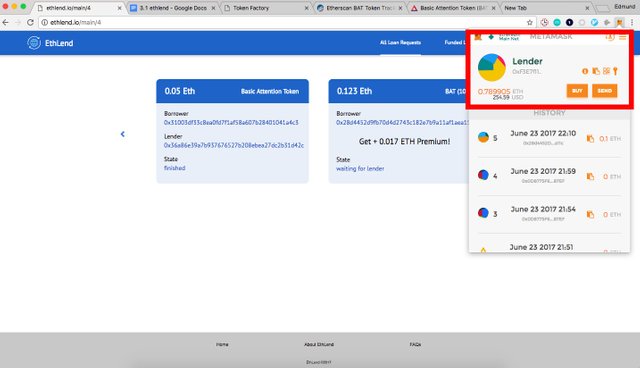
After selecting the loan, lender can click fund this loan request
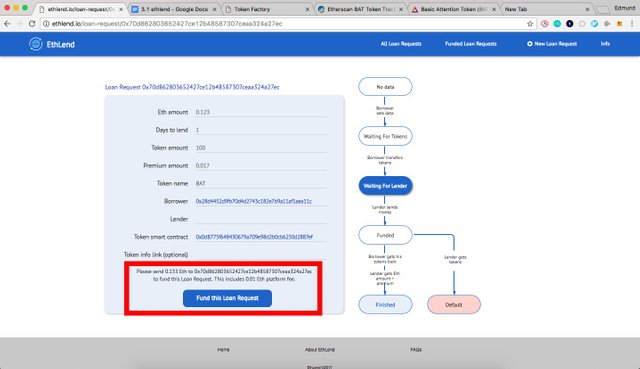
Confirm via MetaMask
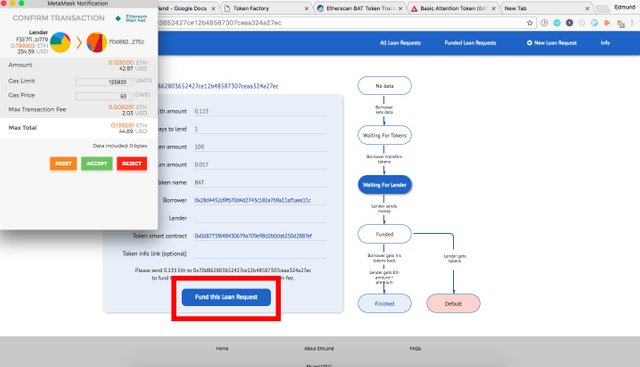
Borrower has successfully received his loan

Paying the Loan Back
As the borrower, you can choose the loan you would like to repay
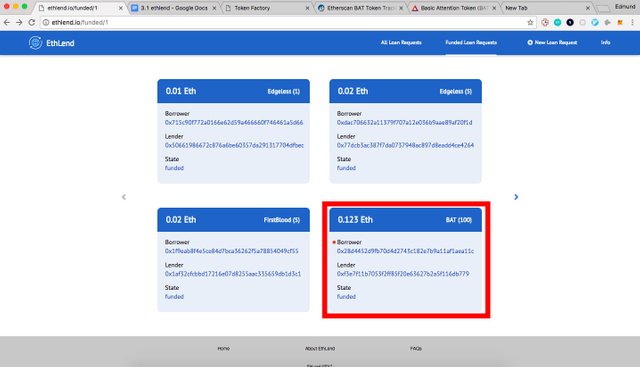
Click return token and confirm via MetaMask

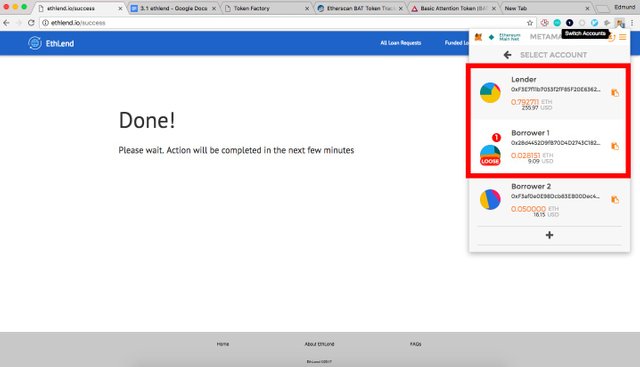
You can see in the balance borrower has returned to lender the loan amount plus interest
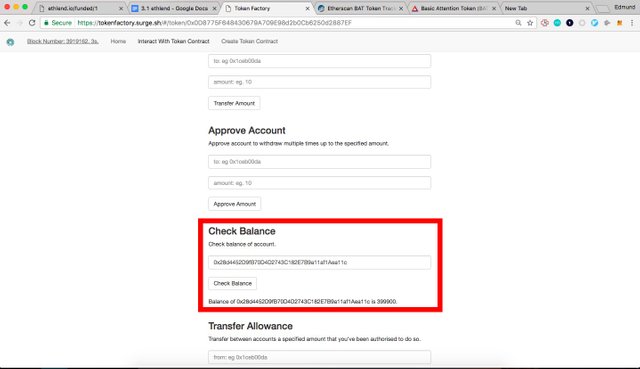
Borrower has received back his token pledged earlier for collateral
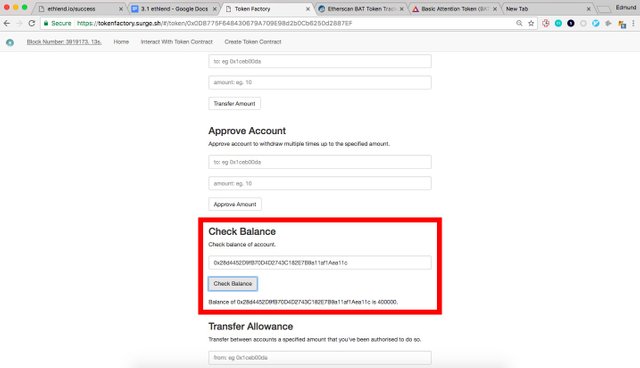
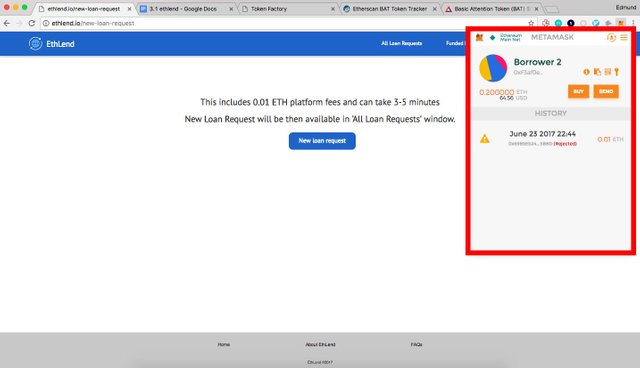
Default Scenario
We are going to demonstrate a default scenario next

We follow identical steps except for the number of days we are putting 0 day to simulate the loan defaulting
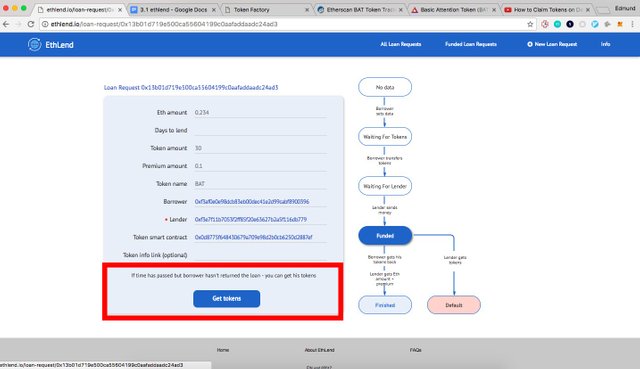
After the loan is defaulted, lender can see the message has changed to get token
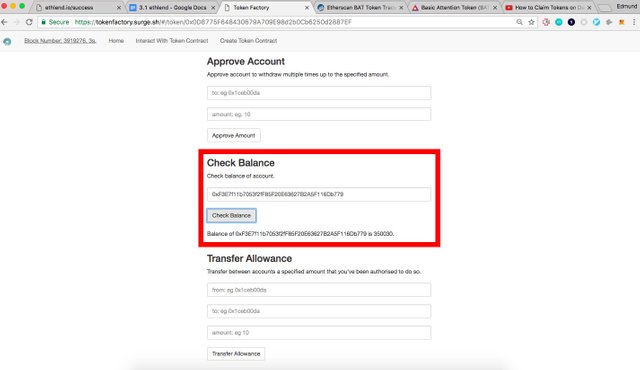
Lender can claim the token and we can confirm on token factory
On-Demand Lending
Learning curve for the borrower. Currently the ETHLend’s decentralized application provides solely that the borrower can create the loan request. This means that the borrower must have a basic understanding on lending. The borrower must place such data as the premium, amount of tokens for pledge and the token Smart Contract address. It might be difficult for a first time borrower to evaluate the value of the ERC-20 token (even if the token is traded on the exchange) and the amount of premium which borrower is willing to accept to pay. If the borrower sets too low premium or overvalues the collateral, the loan might not be attractive for the lenders. This would mean that the loan would not be funded.
Liquidity provided by the lender. Alternative for the borrower’s loan request, ETHLend shall adopt a Smart Contract where the lender may place the loan offer for the borrowers. The lender creates a Loan Smart Contract. The lender inserts data on how much liquidity the lender in total is willing to lend, on what premium, and which tokens the lender is willing to accept for collateral. After the lenders Loan Smart Contract is deployed, anyone may lend from lender simply by sending ERC-20 tokens to the Smart Contract.
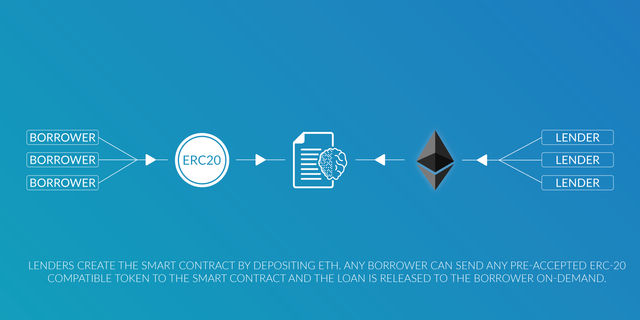
On-demand lending. The lender provides as above state liquidity for any borrower with the pre-set conditions. This means that instead of participating in multiple loan requests, the lender can handle all loans form one Smart Contract. When a borrower returns the loan the, the token is released and sent back to the borrower and the lender Loan Smart Contract has more liquidity for lending. Factually, we have here an on-going lending institution that the lender has created. The lender may at any point close his loan offer. This would mean that no new loans are granted and the borrowed capital will close on due.
Flexibility and shorter learning curve for the borrower. On-demand lending provides flexibility for the lender. The lender does not need to fund single small loans, instead the lender can place the terms for the loan capital and anyone can borrow merely by sending the accepted ERC-20 token to the loan agreement. For the borrower, on-demand lending means less necessary knowledge on lending. The learning curve is transferred from borrower to the lender, which means that the borrower does not have to evaluate the value of the collateral or evaluate the attractiveness of the premium. Of course, if the borrower is not satisfied of the price of the liquidity that the lenders are providing, the borrower may always place a loan request with its own terms.
Secured Lending by Pledging Ethereum Name Service Domains
New name service created a gold rush. Ethereum Name Service Domains (ENS) are domains that are used in the Ethereum ecosystem. ENS domains provides a way to use a name for the long Ethereum address. For example if one would like to send ETH to Jim, the person would need to write long Ethereum address. By using ENS domain one could just sent the ETH to an ENS domain such as jim.eth (which is owned by Jim) and the ETH will be transferred to Jim’s Ethereum address.
ENS domains are auctioned against ETH. ENS domains are not actually bought but the ownerships is guaranteed by willingness to lock ETH for at least a year. When the auction is ended, the new owner of the domain is able to create subdomains, lease, loan or sell the domain. This means that the domain can be sold further to a third party or pledged for a loan. Today, as of 22 June 2017, there are over 75 000 registered domain names. If ENS domains would be ICANN gTLD domain, it would be the 48th largest between solutions and news.
ENS domains have significant value. ENS domains bear at least two forms of value. The first form of value is the ETH that is locked in the domain. For every single .eth domain there is an auction. Today there are 341 643 auctions started. The winning bid of the auction means that the second highest bid ETH amount is locked down on the ENS domain Smart Contract. There are currently 148 312 ETH locked down on ENS domains which results in 50 361 713 USD. Moreover, there are currently almost a billion dollars’ worth of ETH deposited in bids. This means that there are plenty of interest in ENS domains.
Unlocking the benefits of ENS domains. Since ENS domains hold ETH that cannot be used, pledging domains might be perfect option for those that would want to use some of the Locked ETH. The reason practically lies in the fact that unused funds could be placed for use to attract more funds or other use. The highest locked down amount on ENS domain is darkmarket.eth (20 103.10 ETH, equivalent to 6 826 329 USD) and followed by openmarket.eth (10 054.76 ETH, equivalent to 3 414 255 USD). Locking the funds means that these funds could not be used or moved. However, the locked down funds could be used for other purposes such as bidding on other ENS domains or using the funds on other investments instead of letting the funds lie in the ENS domain Smart Contract.
Even though it might not seem idealistic, when .eth domain that holds 0.01 Ether value would be up to pledge. However, ENS domains do have other value than the locked up Ether. Domain names are scarce. This means that even though an ENS Domain might hold as low as 0.01 Ether locked, it might have other value as well. For example, flourist.eth (which is not taken yet) might go for 0.01 Ether. However, the ENS domain might have future value or value for the industry or topic that the domain is related to.
For example, one might create a sophisticated Smart Contract on Ethereum that would track the source of flowers, thus giving an edge to florists’ who adopts the chain. In this sphere, flourist.eth might become quite popular even though the locked value is 0.01 ETH. This would mean that low bid domains is usable for pledge when valued carefully.
ENS domains as a collateral. Domains are great for collateral for two reasons. First, the amount of collateral is the same. When pledging ERC-20 tokens, on can pledge more than one token. When pledging ENS domains, you will have a single value because you cannot pledge more than one domain for the same loan (at this point). This makes things easier.
Secondly, ENS domains can be pledged against the lockdown value to cover the loan amount and the premium. This means that the amount of ETH does not change during the pledge. Therefore, unlike pledging Ethereum-based digital tokens, the borrower could create a loan request that is guaranteed 100% by the ENS domain lockdown without the risk of volatility that ERC-20 tokens might bear.
On the other hand, one must notion that the locked down ETH is released when the domain period ends, usually within a year. However, this does not stop the lender to sell the domain on an auction just as a digital token or hold the domain itself if it is scarce and wait the ecosystem to develop further.
ENS domain collateral Smart Contract. The ENS domain by design is transferrable. Transferability provides that the ENS domains are capable for collateral. When a borrower on ETHLend pledges an ENS domain for a loan, the borrower needs to send the ENS domain to the Smart Contract. The Smart Contract will hold the ENS domain in case the borrower does not repay the loan back. In case of default, the lender is able to claim and transfer the ENS domain to his address for further realization.
Consequently, the ENS domain pledge follows the same roadmap as the tokens pledge. The main distinction is that on token pledge token smart contract address is used for interaction and data. On the other hand, in ENS domain pledge we are using the hash key provided by the ENS registry for transferring the ENS domain to the Smart Contract. The use of Smart Contract additionally guarantees that the address where the received funds are allocated does not change during the pledge, providing security and transparency for the borrower.
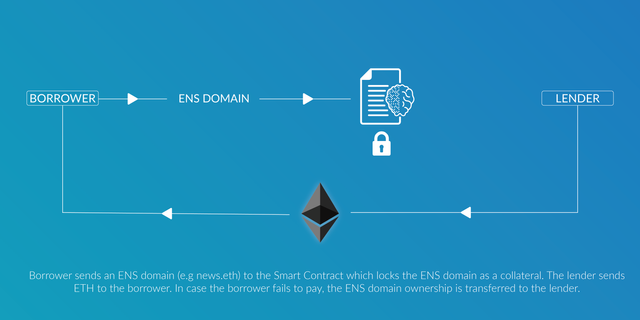
The rapid growth of ENS domains will lock down vast amount of ETH in to the ENS Smart Contracts. This means that at some point there shall be ETH locked that could be worth of billions of USD. Therefore, ENS domain pledge provides a convenient way to “unlock” these funds for use by obtaining funding and pledging the ENS domain. Eventually ENS domains could end up being even more suitable alternative for a collateral for a loan. ENS domains do not have the volatility that some of the ERC-20 tokens might have. Of course, the volatility with the tokens might disappear eventually and would follow such volatility that is seen on stock market or currency exchange. However, since tokens do differ this not the case for all tokens.
-------- pre ico, ico and
ETHLend pre-sale ICO details:
Starting: 25.09.2017 kl. 12.00 GMT
Ending: 25.10.2017 kl. 23.59 GMT or when the cap is reached
AMOUNT TO RAISE: 2 000 ETH
TOKEN FOR SALE: 60 000 000 LEND (6% of total sold tokens)
LEND TOKEN PRICE: 30 000 LEND = 1 ETH
(price includes 20% bonus tokens for all pre-sale participants)
Pre-sold tokens are deducted from the 1 000 000 000 LEND sold on official token sale.
Official ETHLend token sale ICO details:
Starting: 25.11.2017 kl. 12.00 GMT
Ending: 9.12.2017 kl. 23.59 GMT or when the cap is reached
AMOUNT TO RAISE: 37 600 ETH
TOKEN FOR SALE: 1 000 000 000 LEND (deducted by pre-sold tokens)
LEND TOKEN PRICE: First 200 000 000 LEND: 27 500 LEND = 1 ETH
(price includes 10% bonus tokens)
Next 100 000 000 LEND: 26 250 LEND = 1 ETH
(price includes 5% bonus tokens)
Remaining LEND: 25 000 LEND = 1 ETH
https://about.ethlend.io/token-sale/
FastFaq:
What is ETHLend?
ETHLend is a decentralized peer to peer lending platform running on Ethereum blockchain network. Anyone from anywhere from the world can lend and borrow, peer to peer. ETHLend provides the possibility to lend and borrow without borders quickly and efficiently. For example, a borrower in UK does not need to rely on local UK banks and lenders. Instead, with single loan request, the borrower can access funding from all parts of the world. Simultaneously, any lender from Tokyo to Los Angeles can fund this loan request. Safe by design due to the use of smart contracts and blockchain
A short intro video by our Media Correspondent is located at
Who is behind ETHLend?
You can view the team behind ETHLend with their profiles at https://bitcointalk.org/index.php?topic=2090735.0
Where can I get more details and view the whitepaper?
The website contains comprehensive information and is located at http://ethlend.io
White paper is located at: https://github.com/ETHLend/Documentation/blob/master/ETHLendWhitePaper.md
How is volatility managed by ETHLend?
While ETHLend cannot manage the volatility of digital currencies, ETHLend will be introducing USD pegged loans as an option where lender lends USD100 worth of digital currency and receives USD100 worth of digital currency plus premium at the completion of loan term. More information is at https://about.ethlend.io/de/2017/08/13/how-does-the-usd-pegged-loan-work-at-ethlend/
Is the Dapp functional? Where is it located?
dapp is functional and is located here http://app.ethlend.io (Use MetaMask and switch to Mainnet)
also testnet here https://test.ethlend.io . For testnet you need to switch to Kovan from MetaMask and have Kovan Ether (ask from: https://gitter.im/kovan-testnet/Lobby?at=590811ea12d2409935b9919d) and you can create test ERC-20 compatible tokens at: https://tokenfactory.surge.sh/#/factory
What happens to the loaned amount if borrower defaults?
Lending is based on 1. Collaterals: such as ERC-20 compatible tokens (any token) or ENS domains (any domain) or 2. Reputation based lending: when the borrower has repaid collateral based lending, the borrower gains reputation to borrow to a certain (with certain limitations) amount of ETH without a collateral (trusted borrowers).
In case of collateralized loans, the lender can claim the collateral from the smart contract which transfers the collateral to the lenders address in case the borrower has not repaid. The lender may hold or liquidate the collateral in exchange.
On reputation based lending, it is completely different in decentralized environment since it is based on reputation (previously repaid loans and earned Credit Tokens + feedback) if the borrowers defaults the lender burn the borrower’s Credit Tokens. However, nothing stops the parties to conduct a written agreement of the loan to identify each other and enforce the loan is needed. Hence, ETHLend is application that can fulfil various of different types of lending scenarios.
In addition, ETHLend is planning to introduce a decentralized credit rating system, where centralized credit data feeds can be implemented by the use of Oracles. Moreover, there will be other risk assessment tools such as using AI and machine learning to assess Credit Risk or Prediction Market to help credit risk assessment for the borrower.
Can risk of default be shared by lenders on ETHLend?
On risk sharing, crowdlending will be introduced to share risk and a protocol to provide third party decentralized insurance policies or guarantors. The White Paper is quite detailed on the credit risk and risk sharing mechanisms.
Are there any existing loans available?
Yes, you can check listings on the dapp at app.ethlend.io
How can I stay up to date with information related to ETHLend?
You can sign up at our website www.ethlend.io for further updates in addition to joining and following the below mentioned:
Telegram: https://t.me/ETHLend
Website: https://about.ethlend.io/token-sale/
White Paper: https://github.com/ETHLend/Documentation/blob/master/ETHLendWhitePaper.md
Discord (Latest news and voice chats): https://discord.gg/nKjsStv
DAPP Thread: https://bitcointalk.org/index.php?topic=2013399
Reddit: https://www.reddit.com/r/ETHLend/
Facebook: https://www.facebook.com/ETHLend/
YouTube:
Twitter: https://twitter.com/ethlend1
Congratulations @lucax! You have completed some achievement on Steemit and have been rewarded with new badge(s) :
Click on any badge to view your own Board of Honor on SteemitBoard.
For more information about SteemitBoard, click here
If you no longer want to receive notifications, reply to this comment with the word
STOPDownvoting a post can decrease pending rewards and make it less visible. Common reasons:
Submit
Congratulations @lucax! You have completed some achievement on Steemit and have been rewarded with new badge(s) :
Click on any badge to view your own Board of Honor on SteemitBoard.
For more information about SteemitBoard, click here
If you no longer want to receive notifications, reply to this comment with the word
STOPDownvoting a post can decrease pending rewards and make it less visible. Common reasons:
Submit